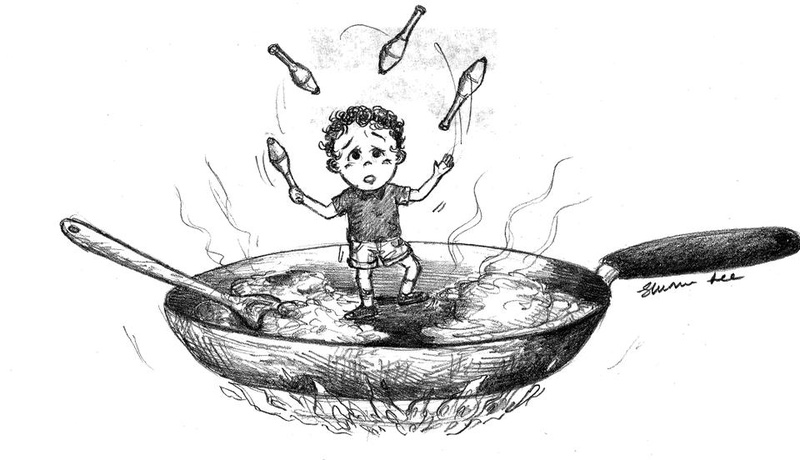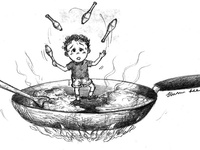A woman with steel hair risks her life, defies gravity, and hangs precariously by her precious hair—and scares the life out of her young daughter each and every time she does it. Aglaja Veteranyi’s posthumously translated semi-autobiographical novel, “Why the Child is Cooking in the Polenta,” is narrated by this unnamed child. The story follows her and her circus-performing parents as they leave Romania and travel through Europe and Africa, and slowly sheds the few bits of structure their fantastical lives had along the way. Translated by Vincent Kling, Veteranyi’s prose brings to life the unlikely perspective of this young girl, an observant yet deeply disturbed child.
Like a circus gone mad, the protagonist’s life slowly spirals out of control. Her father is a drunk who sleeps with her barely pubescent sister; her mother is often overbearingly protective but also shares in her husband’s drunken revelry, which leads her to prostitute the narrator as a child sex performer. The main character is left with few constants in her life except for her mother’s apt collection of chipped porcelain plates—beautiful yet broken—and a mythical story her sister tells her of a child who is cooked alive in polenta.
Veteranyi manages to gather together the shards of this child’s shattered life into a compelling story that describes both tragic and commonplace moments with an unrestrained, creative voice that only a child could possess. With her stream-of-consciousness writing style and poetically sparse prose, Veteranyi successfully pits the playful nature of youth against the morose reality of adult life; she provides a world of commentary through a seemingly quick glimpse of a child’s life.
She writes with deceptively simple prose, a style that her protagonist could easily speak aloud. The writing is fragmented and slightly scattered, just as a child’s thoughts are. “The car trip lasted several years,” she thinks in a realistic exaggeration. Later, she imagines her father’s native language as sounding like “bacon with peppers and sour cream.” This creative perspective, coupled with Veteranyi’s visual style—frequent line and page breaks, and sentences and phrases entirely in capitals—enhances the reality of her prose. The flow is choppy, the words broken up like real-world thoughts at different times. This loose structure and natural impression are two of the author’s greatest strengths: rather than being confusing or awkward, the protagonist’s words seem to emerge naturally even as she jumps around from subject to subject. The story reads like a narration of her life and various thoughts—everything from detailing how her mother slaughters chickens in hotel bathtubs to listing the things she likes to eat.
This straightforward chronicle gains its power from the young girl’s unique declarations about the confusing world she struggles to comprehend. “PEOPLE ARE GOOD BECAUSE THEY’RE AFRAID OF THE DEVIL,” she says at one point. It’s this tone of honesty, as if the child is sharing the things she learns without a filter, that creates a compelling world. Veteranyi’s dry humor contains the same appeal. “I’m very lucky; at least we’re rich enough that I don’t have to eat Boxi,” says the protagonist of her pet. “Anybody with a dog in Romania either lets it starve or makes soup out of it so they won’t starve themselves.”
Veteranyi’s finesse as a writer best emerges not in moments of realization or humor, but rather in those where she harnesses the unique innocent creativity of children. “MY AUNT IS LIKE MY MOTHER’S SHADOW,” she writes in the voice of the protagonist. “But she looks different in every picture, as if she were part of the landscape.” The novel is full of beautiful sentences like these, and most impressive is that she weaves them in while maintaining the protagonist’s voice.
As fragments of the protagonist’s life begin to come together, she grows up and changes. She loses her mother’s wavering protection and her innocence. As her worldview becomes more dark and adult, her invented childhood myth—about why the child is cooking in the polenta—also changes. In the original iterations of the story when the sisters were young, the child climbs into the pot accidentally or hides in the cornmeal. Yet this story eventually comes to represent more than just a family tale. Later, as the protagonist experiences great hardship, her mindset projects itself onto the once-comforting myth: cooking becomes a punishment because the child tortures orphans and sucks the flesh off of their bones. This understated portrayal of emotional changes is an incredibly effective way to convey the emotional and physical upheaval of this young girl’s life.
The terrific tragedy of the protagonist’s life underlies every one of these themes. Within one page, her mother attempts suicide and beats her sister, who makes sure that a man impregnates her so she can escape the clutches of her incestuous father. As things get worse, her life loses structure. People become interchangeable. Her sister becomes her mother, her doll becomes her sister, and her family moves yet again. She is thrown from the itinerant lifestyle of the circus, to a boarding school, back to the circus, to a traveling sex show, to her aunt, back to school, and so forth. Yet Veteranyi is not content with shock-and-awe tragedy. She instead aims for reality.
Throughout the novel, Veteranyi describes the myriad things the circus performers collect: the children’s dolls, the mother’s porcelain plates, and the family’s memories. Yet the girl’s aunt and uncle, at the novel’s end, have accumulated a pile of possessions after settling down: carpets upon carpets, bed sheets, dead people’s clothes, an Elvis poster, and more things the protagonist has never dreamed of until the moment she sees them all. In this moment, Veteranyi gives us a snapshot of what we accumulate in our lifetimes, but throughout the novel she also reminds us that, like material possessions; we accumulate a range of influential experiences—and in this one young girl’s life, those are mostly tragedies. As the circus performers collect possessions optimistically for the day they settle in a huge house, so too can we collect the few moments of joy in the protagonist’s life, hoping she will realize that she can abandon her tragic life and settle down with these few grains of happiness. Yet Veteranyi writes on, determined to portray real emotions at the cost of her characters’ happiness, reminding us again and again of the unbearable sadness of the world.
—Staff writer Keerthi Reddy can be reached at kreddy@college.harvard.edu.
Read more in Arts
Penney Explores Marginalized Culture in ‘The Invisible Ones’Recommended Articles
-
 When the (Jerkus) Circus Comes to Town...
When the (Jerkus) Circus Comes to Town... -
 The Circus Is In Town!
The Circus Is In Town! -
 Circus Skills Help Mayora on the Field
Circus Skills Help Mayora on the Field -
Acrobatic ‘8’ Flies Through ArtsEmersonIn "Sequence 8," world-renowned acrobats and performers take clowning around to a dizzying level.
-
The EtherealsThe Ethereals, who comprise acrobatic Nicolas Maffey ’13 and a live band, will perform at Arts First.
-
 Wilson Forgets "What's Important"
Wilson Forgets "What's Important"















